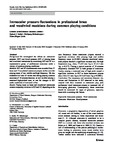Non-linear global pooling in the discrimination of circular and non-circular shapes
| dc.contributor.author | KANG, JUNGHEE | |
| dc.contributor.author | Kennedy, GJ | |
| dc.contributor.author | Orbach, HS | |
| dc.contributor.author | Loffler, G | |
| dc.date.accessioned | 2017-11-16T17:37:51Z | |
| dc.date.available | 2017-11-16T17:37:51Z | |
| dc.date.issued | 2012-06 | |
| dc.identifier.issn | 0042-6989 | |
| dc.identifier.issn | 1878-5646 | |
| dc.identifier.uri | http://hdl.handle.net/10026.1/10194 | |
| dc.description.abstract |
The ability to discriminate minute deviations from circularity is dependent upon global summation mechanisms integrating information along entire contours. The aim of this study was to determine how the strength of global summation depends on various stimulus features. To determine if the strength of global summation differs between shapes, contour discrimination for various contour shapes, generated by applying a sinusoidal modulation to the radius of a circle (radial frequency - RF - patterns), was measured. Shapes differed in frequency (number of lobes RF3, RF5 and RF20) and amplitude ('sharpness' of the lobes ranged between 0 and 20× thresholds for detecting deviation from a circle). Low amplitudes test discrimination against a circle while high amplitudes measure sensitivity for highly non-circular shapes (e.g. five-pointed star-shapes). The ability to integrate information along contours was assessed by comparing the effect of applying radial deformations to the entire contour or to only fractions (various number of cycles). Results show that discrimination thresholds remain in the hyperacuity range for low amplitudes, but increase for higher amplitudes. Concerning signal integration, discrimination, expressed as a function of the amount of contour deformed, exhibits a shallow and a steep regime. Discrimination improves only slowly as more contour cycles are deformed until the point when the entire pattern is modulated, when sensitivity increases substantially. The initial shallow regime is well captured by probability summation. The increase in sensitivity when the entire pattern is modulated compared to a single cycle provides evidence for global pooling. The pattern of integration and the existence of global pooling is dependent on shape frequency. The two-part behavior is independent of shape amplitude but is only seen for low RFs (3 and 5). Data for RF20 follow the prediction of probability summation. We next investigated various stimulus characteristics and their effect on integration strength. Global pooling exceeding probability summation is evident for different pattern sizes, presentation times and for high as well as low absolute contrasts. Only if the contrasts of different fractions of a contour shape are individually scaled to match their respective visibilities is integration strength below the level of probability summation. This explains the lack of apparent global pooling in previous studies employing mixed contrasts. The marked increase in performance for discriminating completely modulated RF patterns argues in favor of highly specialized, global shape mechanisms that are seen over a wide range of stimulus configurations. The results indicate global, non-linear mechanisms, which respond most strongly when stimulated by the entire pattern and comparatively weakly when only stimulated by parts of it. | |
| dc.format.extent | 44-56 | |
| dc.format.medium | Print-Electronic | |
| dc.language | en | |
| dc.language.iso | eng | |
| dc.publisher | Elsevier BV | |
| dc.subject | Shape perception | |
| dc.subject | Global processing | |
| dc.subject | Form vision | |
| dc.subject | Radial frequency | |
| dc.subject | Contour | |
| dc.subject | Probability summation | |
| dc.title | Non-linear global pooling in the discrimination of circular and non-circular shapes | |
| dc.type | journal-article | |
| dc.type | Journal Article | |
| plymouth.author-url | https://www.webofscience.com/api/gateway?GWVersion=2&SrcApp=PARTNER_APP&SrcAuth=LinksAMR&KeyUT=WOS:000305110300006&DestLinkType=FullRecord&DestApp=ALL_WOS&UsrCustomerID=11bb513d99f797142bcfeffcc58ea008 | |
| plymouth.volume | 62 | |
| plymouth.publication-status | Published | |
| plymouth.journal | Vision Research | |
| dc.identifier.doi | 10.1016/j.visres.2012.03.001 | |
| plymouth.organisational-group | /Plymouth | |
| plymouth.organisational-group | /Plymouth/Faculty of Health | |
| plymouth.organisational-group | /Plymouth/Faculty of Health/School of Health Professions | |
| plymouth.organisational-group | /Plymouth/REF 2021 Researchers by UoA | |
| plymouth.organisational-group | /Plymouth/REF 2021 Researchers by UoA/UoA03 Allied Health Professions, Dentistry, Nursing and Pharmacy | |
| plymouth.organisational-group | /Plymouth/Research Groups | |
| plymouth.organisational-group | /Plymouth/Research Groups/Institute of Health and Community | |
| plymouth.organisational-group | /Plymouth/Users by role | |
| plymouth.organisational-group | /Plymouth/Users by role/Academics | |
| dc.publisher.place | England | |
| dcterms.dateAccepted | 2012-03-03 | |
| dc.identifier.eissn | 1878-5646 | |
| dc.rights.embargoperiod | Not known | |
| rioxxterms.versionofrecord | 10.1016/j.visres.2012.03.001 | |
| rioxxterms.licenseref.uri | http://www.rioxx.net/licenses/all-rights-reserved | |
| rioxxterms.licenseref.startdate | 2012-06-01 | |
| rioxxterms.type | Journal Article/Review |


